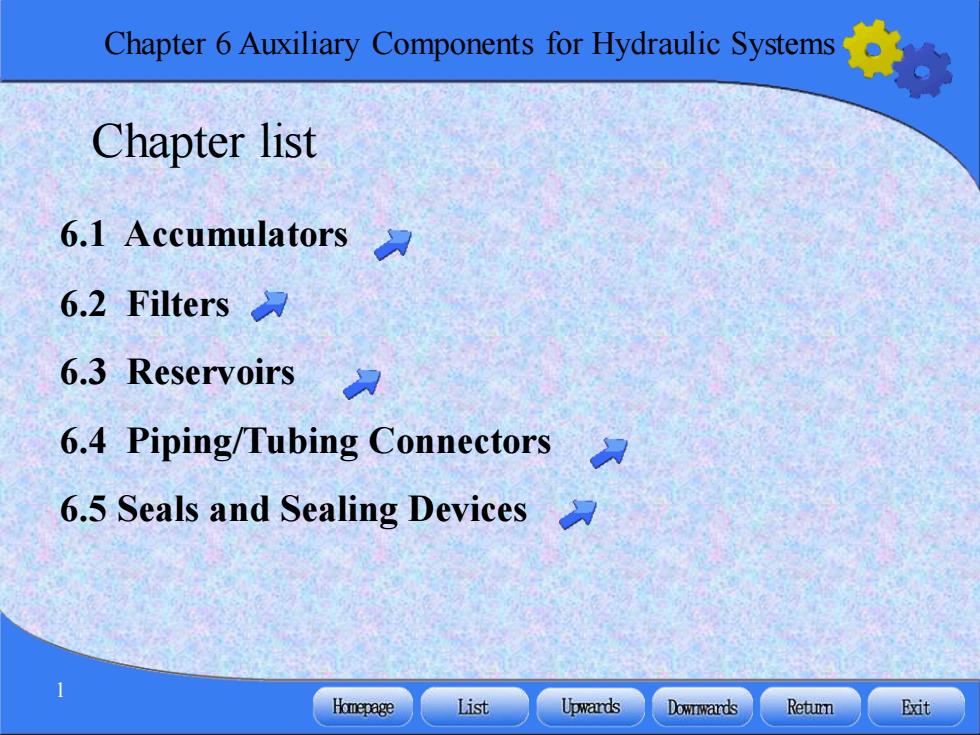
Chmer Componats for Hr ym Chapter list 6.1 Accumulators 6.2 Filters习 6.3 Reservoirs 6.4 Piping/Tubing Connectors 6.5 Seals and Sealing Devices Homepage List Upwards Dowrwards Retun Exit
Chapter 6 Auxiliary Components for Hydraulic Systems 1 6.1 Accumulators 6.2 Filters 6.3 Reservoirs 6.4 Piping/Tubing Connectors 6.5 Seals and Sealing Devices Chapter list
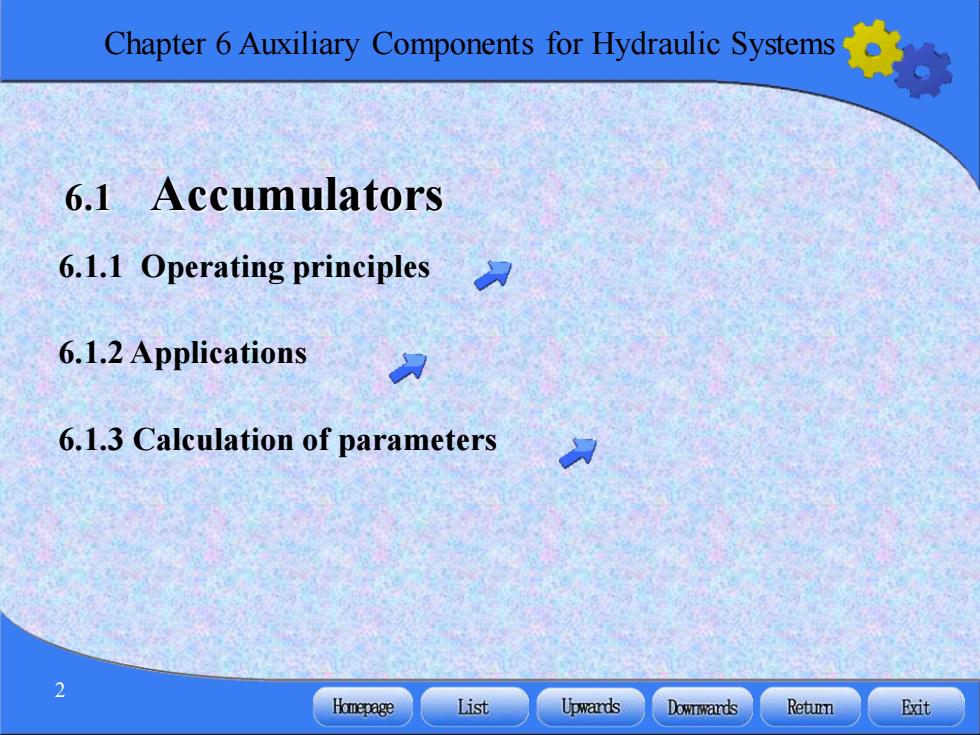
Chaptery Compore for ram 6.1 Accumulators 6.1.1 Operating principles 6.1.2 Applications 6.1.3 Calculation of parameters Homepage List Upwards Downwards Retun Exit
Chapter 6 Auxiliary Components for Hydraulic Systems 2 6.1 Accumulators 6.1.1 Operating principles 6.1.2 Applications 6.1.3 Calculation of parameters
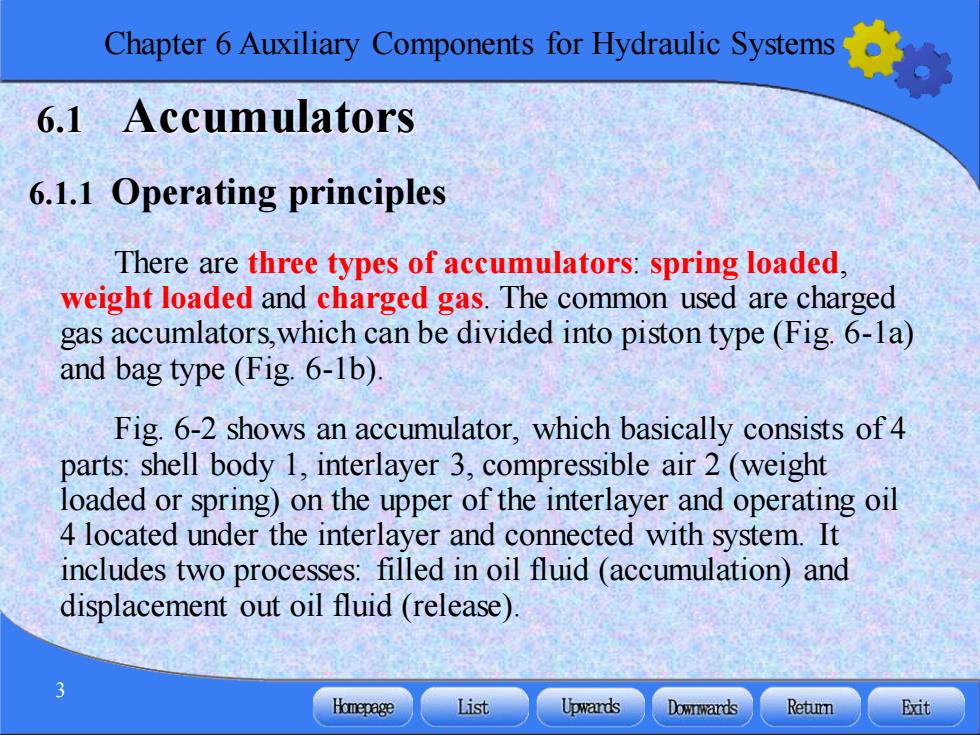
r6 Auxiliary Components for Hydraulic Systs 6.1 Accumulators 6.1.1 Operating principles There are three types of accumulators:spring loaded, weight loaded and charged gas.The common used are charged gas accumlators,which can be divided into piston type(Fig.6-1a) and bag type(Fig.6-1b). Fig.6-2 shows an accumulator,which basically consists of 4 parts:shell body 1,interlayer 3,compressible air 2(weight loaded or spring)on the upper of the interlayer and operating oil 4 located under the interlayer and connected with system.It includes two processes:filled in oil fluid(accumulation)and displacement out oil fluid(release) Homepage List Upwards Downward达 Return Exit
Chapter 6 Auxiliary Components for Hydraulic Systems 3 6.1 Accumulators 6.1.1 Operating principles There are three types of accumulators: spring loaded, weight loaded and charged gas. The common used are charged gas accumlators,which can be divided into piston type (Fig. 6-1a) and bag type (Fig. 6-1b). Fig. 6-2 shows an accumulator, which basically consists of 4 parts: shell body 1, interlayer 3, compressible air 2 (weight loaded or spring) on the upper of the interlayer and operating oil 4 located under the interlayer and connected with system. It includes two processes: filled in oil fluid (accumulation) and displacement out oil fluid (release)
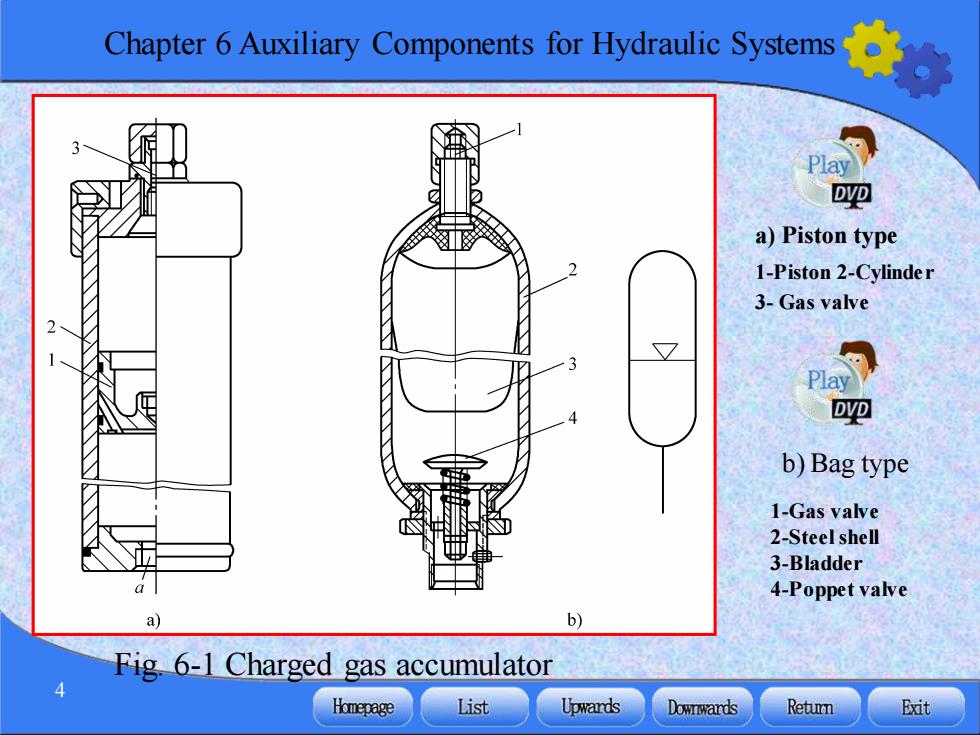
Chapter 6 Auxiliary Components for Hydraulic Systems Play DVD a)Piston type 1-Piston 2-Cylinder 3-Gas valve Play D吧 b)Bag type 1-Gas valve 2-Steel shell 3-Bladder 4-Poppet valve b) Fig 6-1 Charged gas accumulator Homepage List Upwards Downward止 Return Exit
Chapter 6 Auxiliary Components for Hydraulic Systems 4 Fig. 6-1 Charged gas accumulator a) Piston type b) Bag type 1-Piston 2-Cylinder 3- Gas valve 1-Gas valve 2-Steel shell 3-Bladder 4-Poppet valve

Chapter 6 Auxiliary Components for Hydraulic Systems a) b) c) Fig.6-2 Operating principle of accumulator a)After displacement out oil fluid b)Filled in oil fluid c)Displacement out oil fluid 1-Shell 2-Compressible gas(or weight or spring)3-Interlayer 4-Operating fluid 5 Homepage List Upwards Downwards Retun Exit
Chapter 6 Auxiliary Components for Hydraulic Systems 5 Fig. 6-2 Operating principle of accumulator a) After displacement out oil fluid b) Filled in oil fluid c) Displacement out oil fluid 1-Shell 2- Compressible gas ( or weight or spring) 3-Interlayer 4-Operating fluid
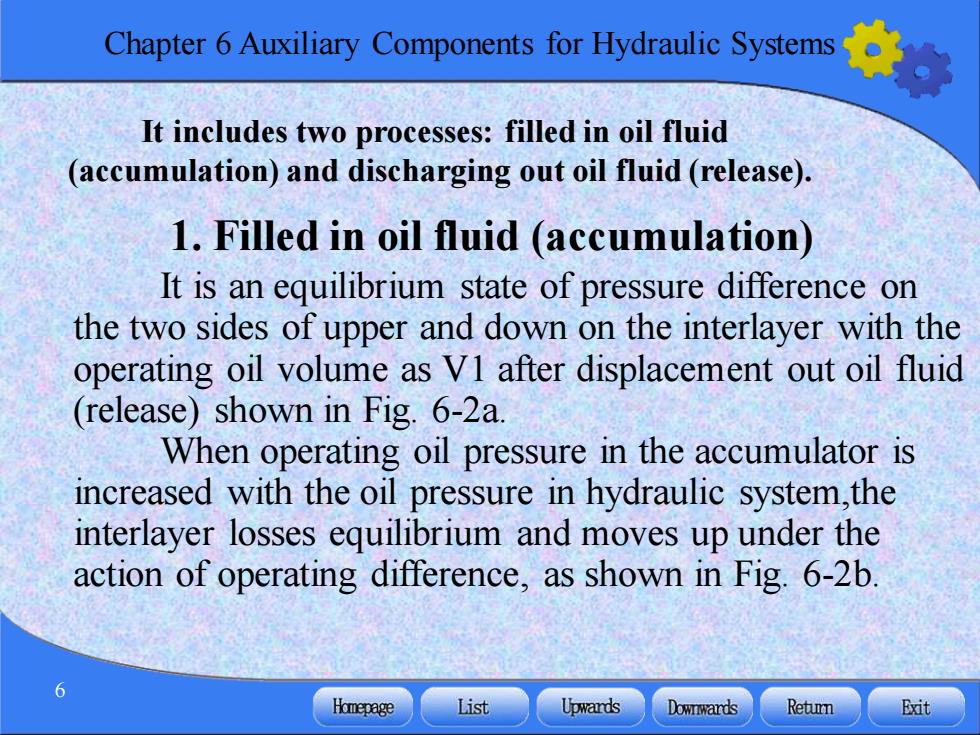
Chapter 6 Auxiliary Components for Hydraulic Systems It includes two processes:filled in oil fluid (accumulation)and discharging out oil fluid(release). 1.Filled in oil fluid(accumulation) It is an equilibrium state of pressure difference on the two sides of upper and down on the interlayer with the operating oil volume as V1 after displacement out oil fluid (release)shown in Fig.6-2a. When operating oil pressure in the accumulator is increased with the oil pressure in hydraulic system,the interlayer losses equilibrium and moves up under the action of operating difference,as shown in Fig.6-2b. Homepage List Upwards Downwards Retumn Exit
Chapter 6 Auxiliary Components for Hydraulic Systems 6 1. Filled in oil fluid (accumulation) It is an equilibrium state of pressure difference on the two sides of upper and down on the interlayer with the operating oil volume as V1 after displacement out oil fluid (release) shown in Fig. 6-2a. When operating oil pressure in the accumulator is increased with the oil pressure in hydraulic system,the interlayer losses equilibrium and moves up under the action of operating difference, as shown in Fig. 6-2b. It includes two processes: filled in oil fluid (accumulation) and discharging out oil fluid (release)
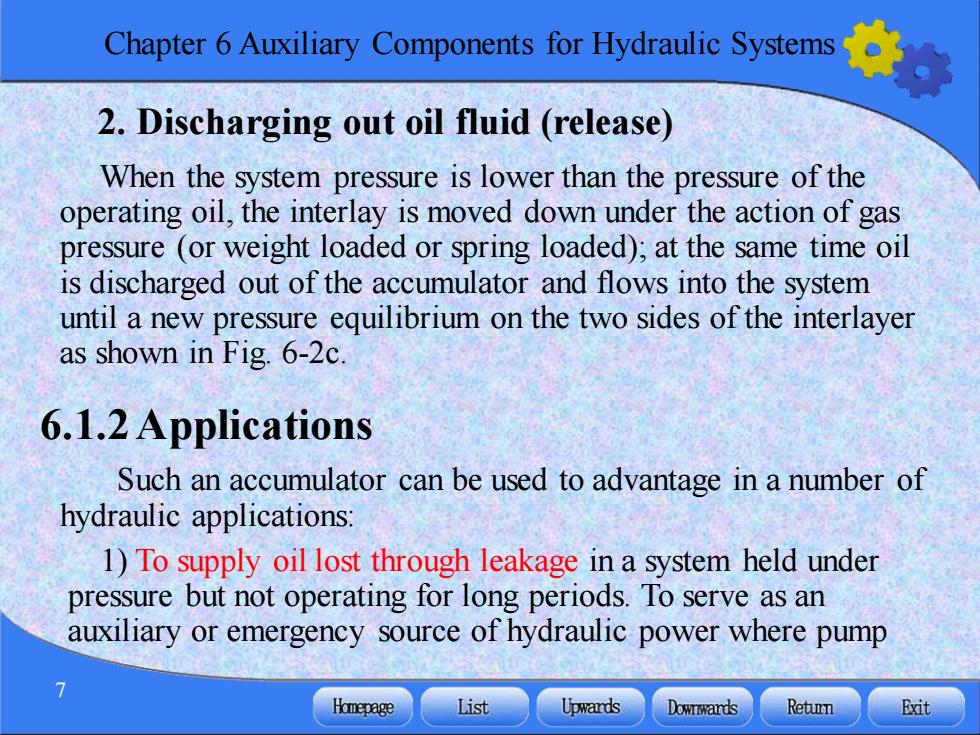
Chapter 6 Auxiliary Components for Hydraulic Systems 2.Discharging out oil fluid(release) When the system pressure is lower than the pressure of the operating oil,the interlay is moved down under the action of gas pressure(or weight loaded or spring loaded);at the same time oil is discharged out of the accumulator and flows into the system until a new pressure equilibrium on the two sides of the interlayer as shown in Fig.6-2c. 6.1.2 Applications Such an accumulator can be used to advantage in a number of hydraulic applications: 1)To supply oil lost through leakage in a system held under pressure but not operating for long periods.To serve as an auxiliary or emergency source of hydraulic power where pump Homepage List Upwards Downward达 Return Exit
Chapter 6 Auxiliary Components for Hydraulic Systems 7 2. Discharging out oil fluid (release) When the system pressure is lower than the pressure of the operating oil, the interlay is moved down under the action of gas pressure (or weight loaded or spring loaded); at the same time oil is discharged out of the accumulator and flows into the system until a new pressure equilibrium on the two sides of the interlayer as shown in Fig. 6-2c. 6.1.2 Applications Such an accumulator can be used to advantage in a number of hydraulic applications: 1) To supply oil lost through leakage in a system held under pressure but not operating for long periods. To serve as an auxiliary or emergency source of hydraulic power where pump
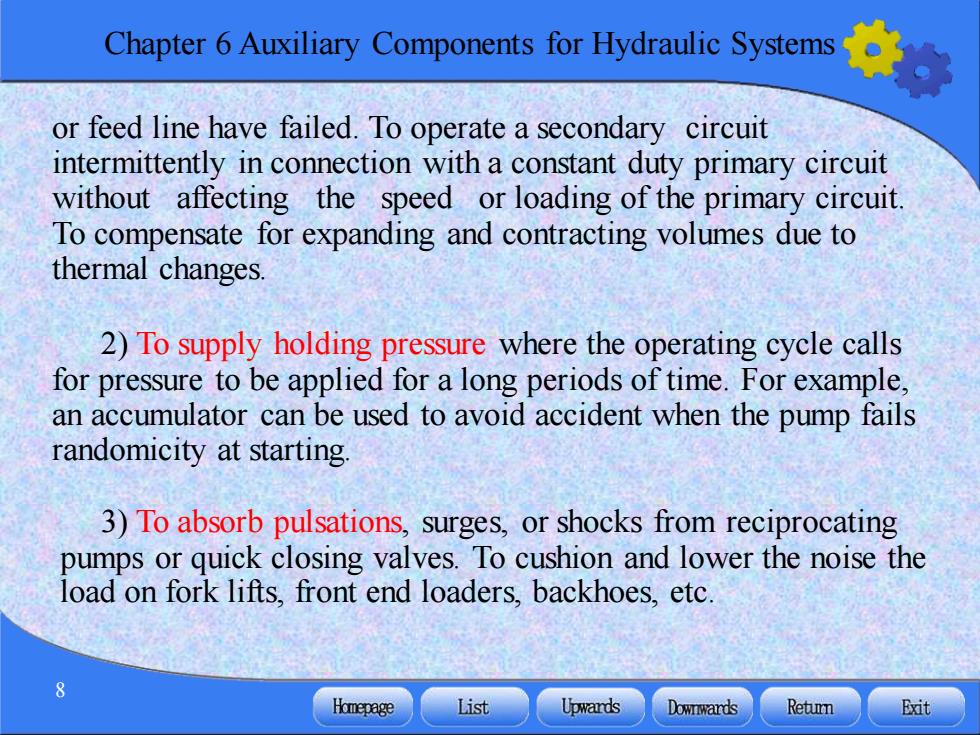
Chapter 6 Auxiliary Components for Hydraulic Systems or feed line have failed.To operate a secondary circuit intermittently in connection with a constant duty primary circuit without affecting the speed or loading of the primary circuit. To compensate for expanding and contracting volumes due to thermal changes. 2)To supply holding pressure where the operating cycle calls for pressure to be applied for a long periods of time.For example, an accumulator can be used to avoid accident when the pump fails randomicity at starting. 3)To absorb pulsations,surges,or shocks from reciprocating pumps or quick closing valves.To cushion and lower the noise the load on fork lifts,front end loaders,backhoes,etc 8 Homepage List Upwards Downwards Return Exit
Chapter 6 Auxiliary Components for Hydraulic Systems 8 or feed line have failed. To operate a secondary circuit intermittently in connection with a constant duty primary circuit without affecting the speed or loading of the primary circuit. To compensate for expanding and contracting volumes due to thermal changes. 2) To supply holding pressure where the operating cycle calls for pressure to be applied for a long periods of time. For example, an accumulator can be used to avoid accident when the pump fails randomicity at starting. 3) To absorb pulsations, surges, or shocks from reciprocating pumps or quick closing valves. To cushion and lower the noise the load on fork lifts, front end loaders, backhoes, etc
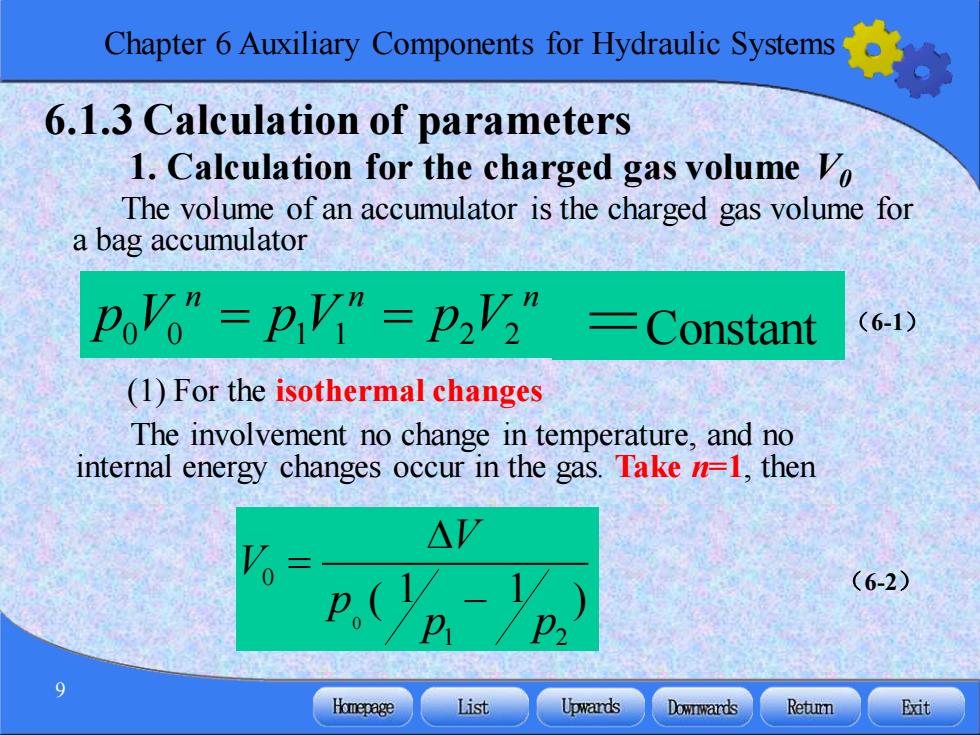
Chapter 6 Auxiliary Components for Hydraulic Systems 6.1.3 Calculation of parameters 1.Calculation for the charged gas volume o The volume of an accumulator is the charged gas volume for a bag accumulator p%”=p”=p2V” -Constant (6-1) (1)For the isothermal changes The involvement no change in temperature,and no internal energy changes occur in the gas.Take n=1,then △V 6-2) p.( Homepage List Upwards Dowrwards Return Exit
Chapter 6 Auxiliary Components for Hydraulic Systems 9 6.1.3 Calculation of parameters 1. Calculation for the charged gas volume V0 The volume of an accumulator is the charged gas volume for a bag accumulator 0 0 1 1 2 2 n n n p V p V p V = = =Constant (6-1) (1) For the isothermal changes The involvement no change in temperature, and no internal energy changes occur in the gas. Take n=1, then 0 0 1 2 ( ) 1 1 V V p p p = − (6-2)
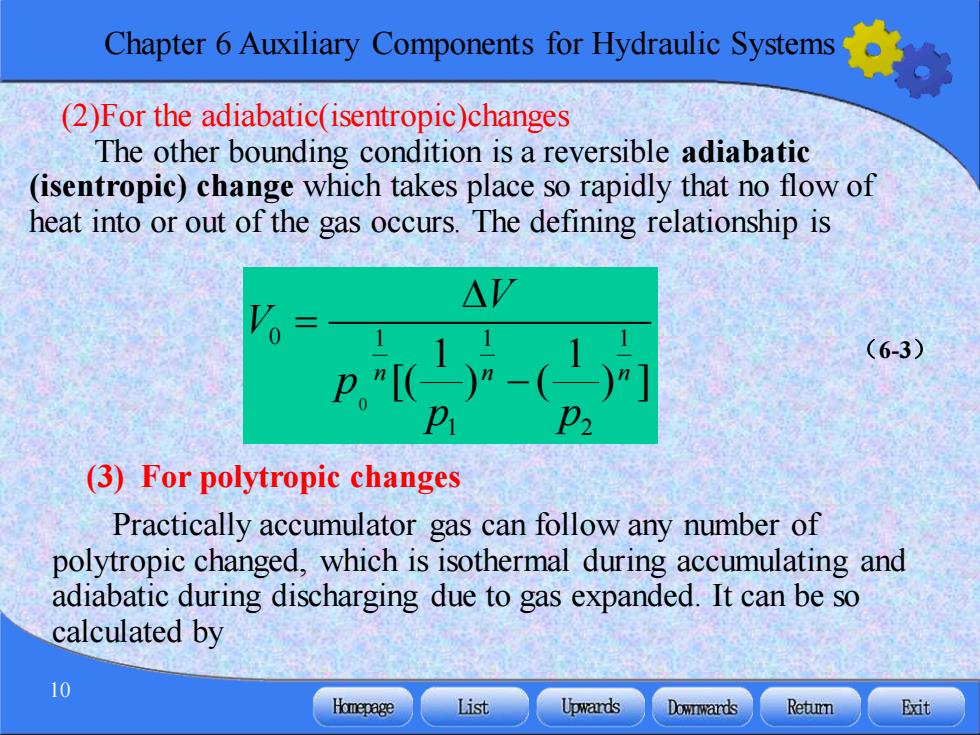
r 6 Auxiliary Components for Hydraulic Sys (2)For the adiabatic(isentropic)changes The other bounding condition is a reversible adiabatic (isentropic)change which takes place so rapidly that no flow of heat into or out of the gas occurs.The defining relationship is △V Vo三1 -(写 1 (6-3) p (3)For polytropic changes Practically accumulator gas can follow any number of polytropic changed,which is isothermal during accumulating and adiabatic during discharging due to gas expanded.It can be so calculated by 10 Homepage List Upwards Downwards Return Exit
Chapter 6 Auxiliary Components for Hydraulic Systems 10 0 0 1 1 1 1 2 1 1 [( ) ( ) ] n n n V V p p p = − (2)For the adiabatic(isentropic)changes The other bounding condition is a reversible adiabatic (isentropic) change which takes place so rapidly that no flow of heat into or out of the gas occurs. The defining relationship is (3) For polytropic changes Practically accumulator gas can follow any number of polytropic changed, which is isothermal during accumulating and adiabatic during discharging due to gas expanded. It can be so calculated by (6-3)